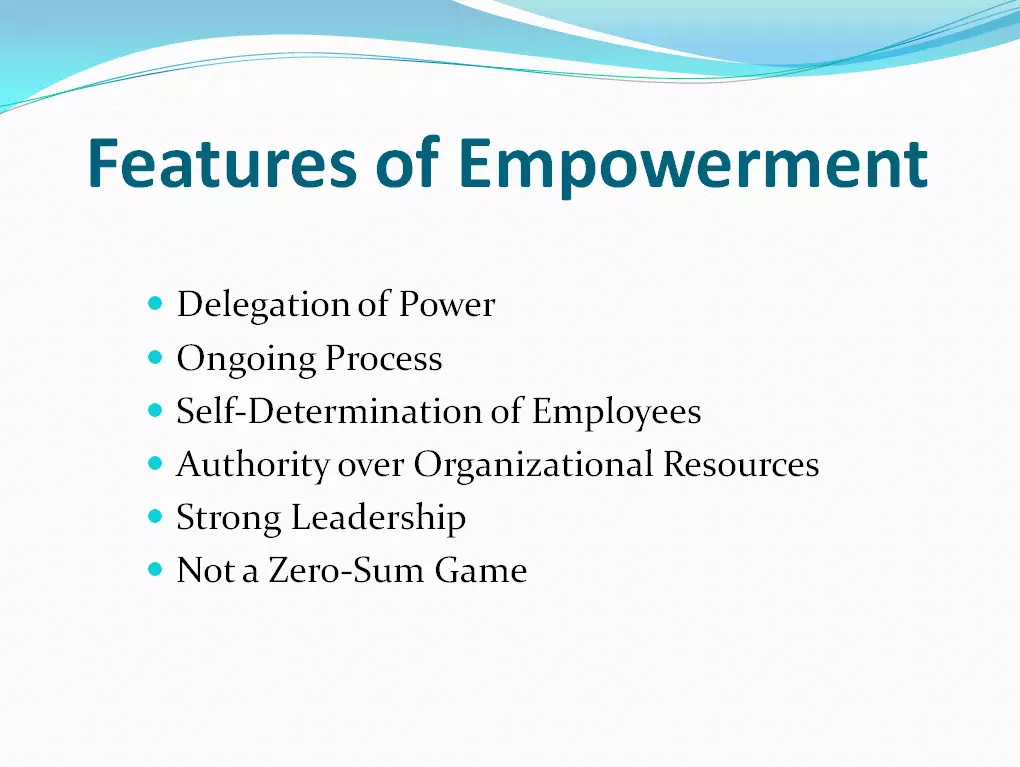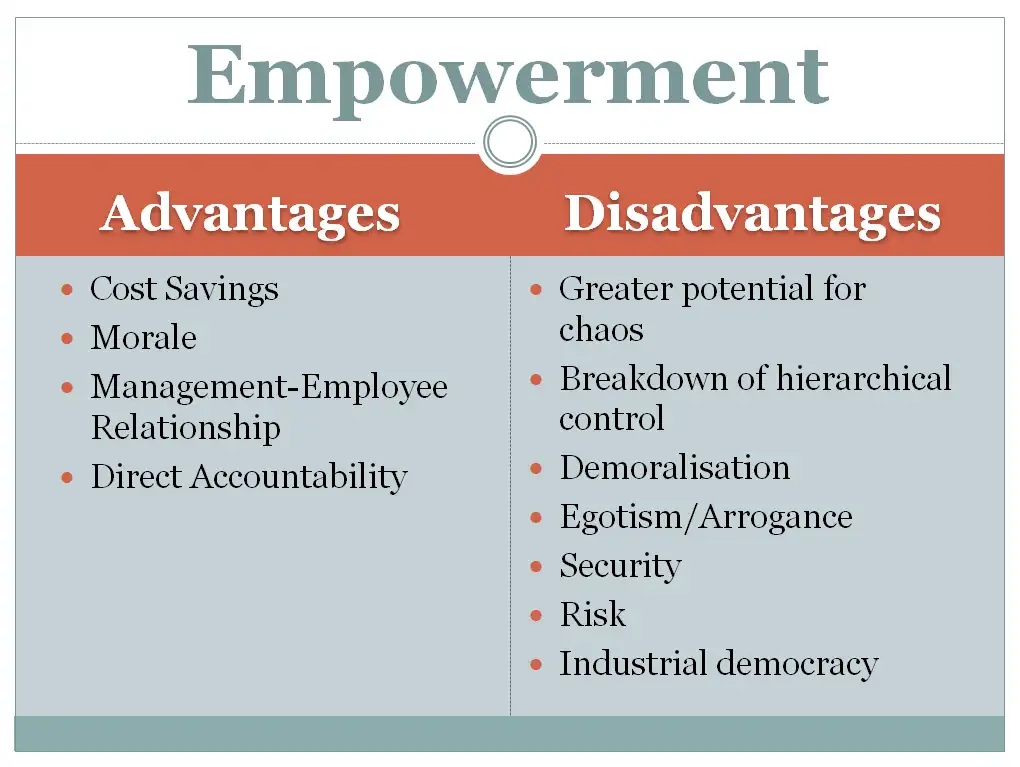Table of Content:-
-
- Meaning of Empowerment
- Definition of Empowerment
- Features of Empowerment
- What is Empowerment?
- Advantages of Empowerment
- Disadvantages of Empowerment
- Elements of Empowerment
- Approaches to Empowerment
- Importance of Empowerment
- Characteristics of Empowered Organisations
- Difference between Traditional and Empowered organisations
- Barriers to Empowerment
Empowerment means giving people the power to control their work life. It is related to participative management. It refers to the enlargement of an employee’s job responsibility by giving him the authority of decision making about his job without the approval of his immediate supervisor. It is the degree of responsibility and authority given to an employee. By empowerment, the employees are supported and encouraged to utilise their skills, abilities, and creativity by accepting accountability for their work. Empowerment occurs when employees are sufficiently trained, equipped with all the necessary tools, have access to all the relevant information, are actively involved in decision making, and are fairly rewarded.
Meaning of Empowerment
Employee empowerment means identifying how much responsibility and authority a person can effectively handle without becoming overburdened or distressed. It involves supervisors and employees working together to establish clear goals and expectations within agreed-upon boundaries.
Empowerment means providing autonomy to individuals to take charge and lead independently by themselves. It refers to giving more power to the employees in terms of resources, tools, skills, and authority that are important to make decisions. Empowered employees become ‘self-directed’ and ‘self-controlled’. This is possible only when there is mutual trust between a superior and their subordinates. The superior has full faith that his subordinates will not do anything, which is detrimental to the organisation.
Similarly, the subordinate has confidence in his superior that he will support his actions and decisions. An empowering manager treats his employees with respect and dignity. He puts authority, responsibility and resources at the most appropriate level for each job. Employee empowerment is a management strategy that provides employees at all levels with the tools and resources that they need to make confident decisions in the workplace without any supervision. It occurs when employees have power, ownership and control over their job. Empowered employees believe that they have a say in how their jobs should be done.
Definition of Empowerment
A few definitions of empowerment are given below:
According to Thomas S. Bateman and Scott A. Snell, “Empowerment is the process of sharing power with employees”.
Richard Kathnelson states, “Empowerment is the process of coming to feel and behave as if one is in power (autonomy and control) and to feel as if he/she owned the firm”.
According to Richard Carver – “Empowerment means encouraging and allowing individuals to take personal responsibility for improving the way they do their jobs and contribute to the organisation’s goals. It requires the creation of a culture which both encourages people at all levels to feel that they can make a difference and helps them to acquire the confidence and skills to do so.”
Nancy Foy states – “Empowerment is simply gaining the power to make your voice heard. to contribute to plans and decisions that affect you, to use your expertise at work to improve your performance and with it the performance of your whole organisation.”
According to John Newstrom and Keith Davis – “Empowerment is any process that provides greater authority through the sharing of relevant information and the provision of control over factors affecting job performance.”
Features of Empowerment
The features of empowerment are as follows:

1) Delegation of Power: Empowerment means the transfer of power from the higher levels of an organization to its grassroots levels. Thus, it involves pushing authority and responsibilities downwards in the organisational structure.
2) Ongoing Process: Empowerment is not an end but an ongoing process to achieve the predetermined goals of the organisation. These goals may include improving employee motivation and organisational performance, accomplishing organisational goals, and obtaining competitive advantages. The empowerment process involves the development of dreams and visions. It involves the fixation of boundaries for authority and responsibility, the training of employees, the determination of accountability for actions, and finally, the actual transfer of authority from superiors to subordinates.
3) Self-Determination of Employees: Organisations often view independent decision making by employees in their job as the ultimate stage of empowerment. At this stage of charge, the employees begin to own the job and accept responsibility for their decisions. Their involvement and commitment levels tend to be high at this ideal level.
4) Authority over Organisational Resources: In empowerment, the employees get freedom from domination by the superiors and the right to exercise authority over organisational resources. The resources here include the physical and human resources of the organisation.
5) Strong Leadership: The presence of strong leadership and decisiveness is an inherent element of successful employee empowerment. Effective leadership makes it explicit to the empowered employees that it is they who are solely responsible for their actions. They get a reward or reprimand, depending on the outcome of their actions.
6) Not a Zero-Sum Game: In a zero-sum game, one person’s loss is precisely another’s gain. However employer empowerment is not a zero-sum game since the transfer of power from the superiors to the subordinates is not a loss of power for the former.
Related Articles:
What is Empowerment?
Empowerment should not be confused with the term delegation of authority. Delegation is actioned by the manager whereas empowerment is actioned by the subordinate.
In the delegation of authority, the superior assigns tasks or responsibilities to subordinates without necessarily providing them with the necessary tools or encouragement to succeed. Whereas empowerment grants individuals the autonomy, resources, and support necessary to make decisions and take ownership of their work. For example, when a father gives his son money to buy a pair of jeans it is delegation. But when a father gives his son a clothing allowance which he can spend as he wants, it is empowerment. Empowerment may be conceptualised as the amount of control exercised by members of a workgroup over work-related decisions relative to the control exercised by the formal manager of the group.
The above figure shows that as employees become more empowered, managers exercise less control over work-related decisions and responsibilities of the workgroups.
There are two types of empowerment–individual and group level. Individual-level empowerment means the degree of control exercised by individual employees over the work setting. Group-level empowerment refers to the amount of power exercised by the group as a whole over the work setting.
Advantages and Disadvantages of Empowerment

Advantages of Empowerment
The advantages of empowerment are as follows:
1) Cost Savings
Employees who perform their tasks daily have an intimate understanding of how their jobs are done. By empowering employees to choose their work methods, companies can benefit from the years of experience each employee has. When employees are allowed to suggest and make procedural changes to their work processes, it can make their jobs more efficient. This in turn helps companies to save money.
2) Morale
When employees are given the power to make decisions and take ownership of their work, they feel a stronger sense of responsibility towards being productive. Putting employees in charge of their results has a positive impact on morale, as employees recognize the value of their contributions to the success of the company. As a result, they are more invested in creating a more efficient and profitable organization. This increased morale also leads to an increase in productivity and a decrease in scheduled time off. This has a positive effect on the company’s bottom line.
3) Management-Employee Relationship
Employee empowerment can help to strengthen the relationships between managers and employees. Managers are seen as coaches and professionals with a direct interest in the success of their employees as opposed to those who dictate policy and give commands. Managers learn to rely on empowered employees, and employees learn to use managers as a resource for getting jobs done.
4) Direct Accountability
Empowering employees to make their own decisions means that employees have direct accountability for their jobs. This is advantageous for companies because instead of harnessing managers with the responsibility for all decisions, employees pick up some of the decision making slack. Thus, it becomes easier to identify the specific causes of problems. Companies can offer specific employees training and any other information needed to correct errors instead of spending time and money training entire departments.
Disadvantages of Empowerment
The disadvantages of empowerment are as follows:
1) Greater Potential for Chaos
The same local action that can lead to prompt customer service can also lead to conflicting messages being given to customers and across departments. One employee may be willing to go further than the next in taking care of a particular need leaving customers with different levels of service The distributed decision-making may also lead to a lack of clarity about who is responsible for what. Job definitions become less useful.
2) Breakdown of Hierarchical Control
When people from different departments or teams start working together in an organization, it means that there is a shift away from the traditional hierarchical structure and the formal structure for making decisions is becoming less important. Instead of following a strict hierarchy, employees are collaborating and share ideas across different areas. Cross-functional teams may do an excellent job of problem-solving but managers with ultimate responsibility for functional units are likely to feel a real loss of control, which they may reject as too risky.
3) Demoralisation
Although empowerment is attractive to many people, it can be demoralizing as well. Not all employees want the responsibility that comes with it. Such people who prefer not to be burdened with additional responsibility may become seriously demoralised if they are forced to take a more active role in the management of their organisations.
4) Egotism/Arrogance
Worker arrogance can cause problems and trouble for supervisors and managers. There can be problems in delegating. Employees avoid reporting about their work and feedback can be taken negatively by them.
5) Security
Since the information comes and is shared by all, there are apprehensions about the leakage of critical data.
6) Risk
Creativity and innovation demand a greater risk-bearing capacity and equal chances of success and failure. Workers often lack the expertise to execute, which can cost big.
7) Industrial Democracy
Labour unions and workers are empowered and they may misuse the same. Strikes and lock-outs become more frequent. Also, labour unions gain insights into management and their functioning and leak the same.
Elements of Empowerment
Personal control, self-sufficiency, meaningfulness and impact are the elements of empowerment. These main elements of empowerment are as follows:
1. Sense of personal control over someone’s immediate work situation.
2. Self-sufficiency or Competence: It means the feeling that one is capable of successfully performing a particular task. Employees will not accept responsibility for making decisions until they are confident in their abilities.
3. Meaningfulness: It means the feeling that the task is valuable both in the organisation and to oneself. Employees know how their tasks fit into the larger scheme of things.
4. Impact: It refers to the belief that one influences the decisions of the organisation. Employees feel influenced when they perceive that their behaviour has resulted in significant consequences.
(a) Impact: When an employee feels that completion of a task “will make a difference,” such a task has an impact on him.
(b) Competence: When a person has confidence that he has the ability, knowledge and skill to perform the task assigned, then such tasks positively affect competence.
(c) Meaningfulness: When an employee feels that the task assigned to him is worthwhile and he cares to do so, such a task is meaningful.
(d) Choice: A task which provides him freedom of decision-making initiative and action, we find the factor “choice” in such a task.
Approaches to Empowerment
Approaches to empowerment include job mastery, control, role models, reinforcement and support. These five approaches to empowerment are as follows:
1. Helping employees achieve job mastery –
giving coaching, training and guided experience that is required for initial success.
2. Allowing more control –
giving employees discretion over job performance and making them accountable for their performance outcomes.
3. Providing successful role models –
allowing them to observe subordinates who are performing successfully on the job.
4. Using social reinforcement and persuasion –
giving promises, encouragement and verbal feedback to raise confidence.
5. Giving emotional support –
reduction of stress and anxiety through better task assistance, role prescription, and personal care.
Importance of Empowerment
Knowledge workers, intense competition, speed and flexibility, globalisation and human resource development highlight the importance of empowerment.
1. Knowledge Workers
Knowledgeable employees are not prepared to accept the old command and control systems. They want a job environment which provides them with opportunities for exercising control over work-related decisions. Organisations which fail to provide such opportunities continuously lose their best employees.
2. Cut Throat Competition
To survive and grow in a competitive era organisations must meet the needs of customers more effectively. For this purpose. cross-functional working and close cooperation is required. Empowerment can provide such cooperation. When the customer demands rapid action it is easier to meet the demand through employee empowerment than through changes in the process and technology.
3. Speed and Flexibility
Growing turbulence of the environment requires a quick response which is not possible under the old command and control model of organisational functioning. Empowerment encourages innovation and creativity on the part of the staff. Empowered managers can focus more on external changes than internal problem-solving of the organisation.
4. Globalisation
Economic liberalisation and globalisation are leading to downsizing, delayering and decentralisation. To achieve coordination and control in the new economy, staff must exercise much greater responsibility.
5. Human Resource Development
Empowerment helps to reveal and utilise the untapped potential of employees. Thus, employee empowerment helps to develop a responsive, flexible, and adaptive organisation. It represents a major cultural change representing the way an organisation defines itself, its priorities and values and the way it deals with its people to change their mindsets.
Characteristics of Empowered Organisations
1. Everyone in the organisation is valued and trusted.
2. An organisational culture which is open and responsive to change.
3. Giving employees opportunities to perform to their maximum effectiveness and make personal contributions.
4. A flat organisation structure with few levels of authority and a decentralised set-up.
5. Information sharing and feedback.
6. Semi-autonomous and cross-functional work groups or teams.
Difference between Traditional and Empowered organisations
| Element | Traditional organisation | Empowered organisation |
| 1. Job Design | Narrow single task | Wide multiple tasks |
| 2. Structure | Layered and individual | Flat and team |
| 3. Management Role | Direct or Control | Coach and facilitate |
| 4. Rewards | Individual and seniority-based | Team and skill-based |
| 5. Information Flow | Controlled and limited | Open and shared |
| 6. Leadership | Top-down | Shared with the team |
| 7. Job Process | Managers plan, control and improve | Team plan, control and improve |
Barriers to Empowerment
Some of the common barriers to empowerment are Incongruent organisational culture, love for authority, and retribution by superiors. retribution by subordinates and the habit of dependency.
All these are explained below:
1. Incongruent Organisational Culture
An authoritarian organisational culture works as an impediment to employee empowerment. In such a culture authority is centralised at the top and there is a lack of meaningful sharing of authority Most of the decisions are made at higher levels and there is a lack of involvement of lower-level staff. Unless this type of organisational culture is changed, empowerment cannot be effective.
2. Love for Authority
Power-hungry managers cannot empower the staff. Such managers are autocratic. They want to make their importance felt in the organisation. They even expect their subordinates to come frequently to get their decisions approved. They try to maintain tight control over subordinates.
3. Fear of Retribution by Superiors
A manager may not empower his employees if he is punished for every failure or mistake of his subordinates. A typical example is that of firing a coach if the team fails to win a match.
4. Fear of a Retribution by Subordinates
Empowerment cannot flourish when there is fear in the minds of subordinates that they will be punished for taking initiative.
5. Dependency of Subordinates
Some subordinates always feel comfortable with command and control by the boss. They may have external-locus-of-control personalities or may be under prolonged autocratic leadership. Empowerment will be difficult with such subordinates.
Factors that make empowerment effective
In the present-day competitive world, no progressive organisation can overlook empowerment. Impact, Competence, Meaningfulness, and Choice have been suggested by Thomas and Velthouse to make empowerment effective.
1. Impact
When an employee feels that the completion of a work performed by him will make a difference, such a task has an impact on his performance.
2. Competence
When the employee has the ability, skills and knowledge to perform a task, he feels a sense of competence.
3. Meaningfulness
When the employee feels that the work assigned to him is meaningful, he develops a sense of meaningfulness about the work.
4. Choice
When the employee feels that he has the freedom to make decisions and initiate actions, he experiences a sense of choice.
